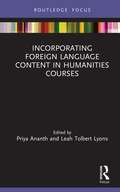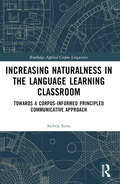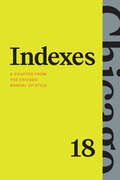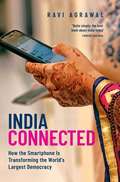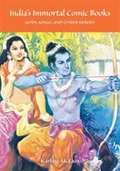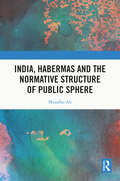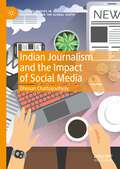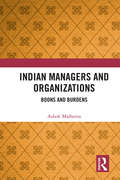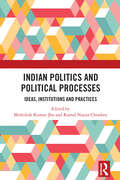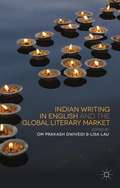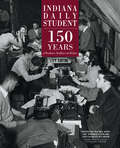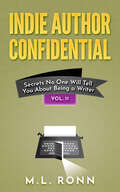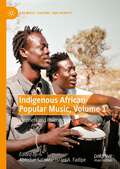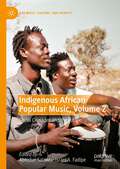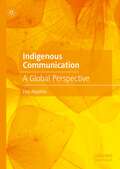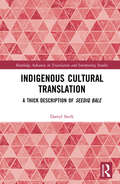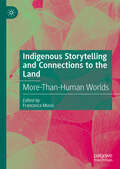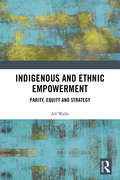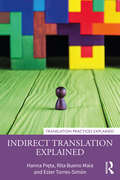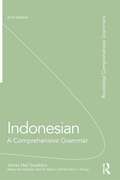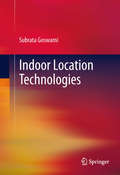- Table View
- List View
Incorporating Foreign Language Content in Humanities Courses
by Priya Ananth Leah Tolbert LyonsIncorporating Foreign Language Content in Humanities Courses introduces innovative ways to integrate aspects of foreign language study into courses containing humanities concepts. The edited collection offers case studies from various universities and across multiple languages. It serves as a useful guide to all foreign language faculty with any language expertise (as well as others interested in promoting foreign languages) for the adaptation and development of their own curricula. Infusing foreign language content into English-taught humanities courses helps promote languages as practical and relevant to students. It will be of interest to language educators, including teachers, teachers-in-training, teacher educators, and administrators.
Increasing Naturalness in the Language Learning Classroom: Towards a Corpus-Informed Principled Communicative Approach (ISSN)
by Szilvia SzitaThis volume links corpus research to classroom practice and critically assesses how the integration of a corpus-informed methodology affects pedagogical choices, teaching materials and classroom activities. Focusing on the language classroom, and drawing on examples from English, French, German and Hungarian, this book demonstrates that such methodology is applicable to languages with very different properties.Drawing on both larger, general and smaller, more specialised corpora, including both spoken and written data, this volume: presents the key features of natural language according to corpus linguistics, establishing principles and methods to observe and practice natural-sounding language use suggests the characteristics of a coherent, corpus-informed methodology and contrasts this with existing methodologies explores ways in which this methodology can enhance language learning and discusses the types of activities that are most effective explains how this methodology be integrated into teacher training Bridging the long-persisting gap between corpus-informed language teaching research and applied classroom reform, this book is key reading for researchers in applied linguistics and language pedagogy, as well as teacher trainers and practitioners.
Independent Politics
by Samara Klar Yanna KrupnikovThe number of independent voters in America increases each year, yet they remain misunderstood by both media and academics. Media describe independents as pivotal for electoral outcomes. Political scientists conclude that independents are merely 'undercover partisans': people who secretly hold partisan beliefs and are thus politically inconsequential. Both the pundits and the political scientists are wrong, argue the authors. They show that many Americans are becoming embarrassed of their political party. They deny to pollsters, party activists, friends, and even themselves, their true partisanship, instead choosing to go 'undercover' as independents. Independent Politics demonstrates that people intentionally mask their partisan preferences in social situations. Most importantly, breaking with decades of previous research, it argues that independents are highly politically consequential. The same motivations that lead people to identify as independent also diminish their willingness to engage in the types of political action that sustain the grassroots movements of American politics.
Indexes: A Chapter from "The Chicago Manual of Style," Eighteenth Edition
by The University of Chicago Press Editorial StaffIndexing A–Z from The Chicago Manual of Style—the undisputed authority for style, usage, and grammar. In this age of searchable text, the need for an index made with human input is sometimes questioned. But a good index can do what a plain search cannot: It gathers all the substantive terms and subjects of the work, sorts them alphabetically, provides cross-references to and from related terms, and includes specific page numbers or other locators or, for electronic formats, direct links to the text. This painstaking intellectual labor serves readers of any longer work, whether it is searchable or not. For searchable texts, an index provides insurance against fruitless queries and unintended results. In a word, a good index makes the text more accessible. Most book indexes must be assembled swiftly between the time page proofs are issued and the time they are returned to the typesetter—usually about four weeks. An author preparing their own index will have to proofread as well as index the work in that short time span. This insightful chapter-length booklet will guide both professionals and first-time indexers in assembling an index that will do justice to both the book and the reader.
India Connected: How the Smartphone is Transforming the World's Largest Democracy
by Ravi AgrawalIndia is connecting at a dizzying pace. In 2000, roughly 20 million Indians had access to the internet. In 2017, 465 million were online, with three new people logging on for the first time every second. By 2020, the country's online community is projected to exceed 700 million; more than a billion Indians are expected to be online by 2025. While users in Western countries progressed steadily over the years from dial-up connections on PCs, to broadband access, wireless, and now 4G data on phones, in India most have leapfrogged straight into the digital world with smartphones and affordable data plans. What effect is all this having on the ancient and traditionally rural culture dominated by family and local customs? Ravi Agrawal's book explores that very question, seeking out the nexuses of change and those swept up in them. Smartphones now influence arranged marriages, create an extension of one's social identity that moves beyond caste, bring within reach educational opportunities undreamed of a generation ago, bridge linguistic gaps, provide outlets and opportunities for start-ups, and are helping to move the entire Indian economy from cash- to credit-based. The effects are everywhere, and they are transformative. While they offer immediate access to so much for so many, smartphones are creating no Utopia in a culture still struggling with poverty, illiteracy, corruption, gender inequality, and income disparity. Internet access has provided greater opportunities to women and altered how India's outcasts interact with the world; it has also made pornography readily available and provided an echo chamber for rumor and prejudice. Under a government determined to control content, it has created tensions. And in a climate of hypernationalism, it has fomented violence and even terrorism. The influence of smartphones on the world's largest democracy is pervasive and irreversible, disruptive and creative, unsettling and compelling. Agrawal's fascinating book gives us the people and places reflecting what the internet hath wrought. India Connected reveals both its staggering dimensions and implications, illuminating how it is affecting the progress of progress itself.
India and the Islamic Heartlands
by Sood Gagan D. S."Based on the chance survival of a remarkable cache of documents, India and the Islamic Heartlands recaptures a vanished and forgotten world from the eighteenth century spanning much of today's Middle East and South Asia. Gagan Sood focuses on ordinary people--traders, pilgrims, bankers, clerics, brokers, scribes, among others--who were engaged in activities marked by large distances and long silences. By elucidating their everyday lives in a range of settings, from the family household to the polity at large, Sood pieces together the connective tissue of a world that lay beyond the sovereign purview. Recapturing this obscured and neglected world helps us better understand the region during a pivotal moment in its history, and offers new answers to old questions concerning early modern Eurasia and its transition to colonialism"--
India's Immortal Comic Books: Gods, Kings, And Other Heroes
by Karline McLainCombining entertainment and education, India's most beloved comic book series, Amar Chitra Katha, or "Immortal Picture Stories," is also an important cultural institution that has helped define, for several generations of readers, what it means to be Hindu and Indian. Karline McLain worked in the ACK production offices and had many conversations with Anant Pai, founder and publisher, and with artists, writers, and readers about why the comics are so popular and what messages they convey. In this intriguing study, she explores the making of the comic books and the kinds of editorial and ideological choices that go into their production.
India, Habermas and the Normative Structure of Public Sphere
by Muzaffar AliThis book examines how the contemporary Indian situation poses a strict theoretical challenge to Habermas’s theorization of the public sphere and employs the method of samvāda to critically analyse and dissect its universalist claims. It invites the reader to consider the possibility of imagining a normative Indian public sphere that is embedded in the Indian context—in a native and not nativist sense—to get past the derivative language of philosophical and political discourses prevalent within Indian academia. The book proposes that the dynamic cooperative space between Indian political theory and contemporary Indian philosophy is effectively suited to theorize the native idea of the Indian public sphere. It underlines the normative need for a natively theorized Indian public sphere to further the multilayered democratization of public spheres within diverse communities that constitute Indian society. The book will be a key read for contemporary studies in philosophy, political theory, sociology, postcolonial theory, history and media and communication studies.
Indian Journalism and the Impact of Social Media (Palgrave Studies in Journalism and the Global South)
by Dhiman ChattopadhyayThis book is a pan-India study that examines social media’s impact on Indian journalism, highlights emerging challenges, and discusses the way forward for India’s newsrooms. A result of three years of field work, the project uses mixed-methods research – a survey of nearly 300 journalists from 15 Indian cities, followed by in-depth interviews with 25 senior editors – to analyze and explain journalists’ perceptions about social media’s usefulness and credibility, factors that influence their online news sourcing and sharing decisions, resultant challenges for newsrooms, and ways to address those challenges. The findings offer unique insights into how newer forces are influencing journalistic practices in an online-first era. Key differences emerge in perceptions between Indian journalists and their Western compatriots about who or what influence their actions. The findings also raise questions about Gatekeeping as a term to describe journalistic work in 21st Century India's newsrooms. The findings and the conclusions will hopefully help journalists, educators, and anyone interested in Indian journalism gain a deeper, more meaningful understanding about social media’s impact on Indian journalism, and the way ahead for India’s newsrooms.
Indian Managers and Organizations: Boons and Burdens
by Ashok MalhotraCulture is critical to individuals and organizations. This book takes a close look into the way Indian managers work, their inner struggles, and forces that shape their behaviour. It presents an original framework developed by the author — the Existential Universe Mapper (EUM), a pluralistic and non-reductionist model of management that uses a new psychometric instrument to map individual and organization identity. The model restrains from placing any phenomenon into frozen categories and enables an understanding of their interplay. The volume points to India’s ambivalent relationship with modernity, and the consequent difficulty of Indian managers in embracing the imperatives of the corporate world that are largely based on Anglo-Saxon frames. This book will be of interest to those in business management, human resource management, leadership studies, corporate governance, industries, education, social sector, governance, psychology, and sociology. It will be particularly relevant for scholars, educators, consultants, practitioners of management and corporate leaders.
Indian Politics and Political Processes: Ideas, Institutions and Practices
by Mithilesh Kumar Jha Kamal Nayan ChoubeyIndian Politics and Political Processes explores the key ideas, foundations, continuities, major shifts and challenges to the state and democracy in modern India. The book presents an in-depth analysis of recent issues and challenges confronting the Indian state and politics. Presenting a comprehensive account of the major trajectories of Indian politics, this book introduces the readers to the existing literature and enables them to think critically about major issues and institutions of politics and democracy. The chapters engage critically with the historical antecedents, major debates, and recent developments. The book also elaborately deals with issues such as populism, religious movements, minority rights, health, and the environment, which are often ignored or side-lined in the available literature on Indian politics and political processes. The book will be useful to the students, teachers and researchers pursuing courses in political science, South Asian Studies, and international/global politics and economics. It will also be an informative read for those interested in contemporary South Asian politics.
Indian Writing in English and the Global Literary Market
by Om Prakash DwivediIndian Writing in English and the Global Literary Market delves into the influences and pressures of the marketplace on this genre, contending that it has been both a gatekeeper and a significant force in shaping the production and consumption of this literature. As well as providing case studies of selected contemporary Indian novels in English and comparing how diasporic authors fare compared to authors within India, this volume also provides theoretical insights into the postcolonial framework in which the global literary marketplace is embedded, and comments on the exoticization and marketing strategies adopted as a result.
Indiana Daily Student: 150 Years of Headlines, Deadlines and Bylines (Well House Books)
by Rachel Kipp, Amy Wimmer Schwarb and Charles ScudderThe story of a student-produced newspaper since its debut in 1867—including photos, coverage of historic events, and reminiscences from prominent alumni.Generations of student journalists, armed with notepads, cameras, and a tireless devotion, have pursued both local and national stories for the student-produced newspaper at Indiana University Bloomington since its debut in 1867.In Indiana Daily Student: 150 Years of Headlines, Deadlines and Bylines, editors and IDS alumni Rachel Kipp, Amy Wimmer Schwarb, and Charles Scudder piece together behind-the-scenes remembrances from former IDS reporters and photographers, newsroom images from throughout the decades, and a curated collection of notable IDS front pages. From coverage of the end of World War I to the selection of Herman B. Wells as IU’s president to the Hoosiers’ national basketball championship titles to the terrorist attacks of Sept. 11, 2001, the IDS has chronicled news from a student perspective. Today, it serves as a training ground for fledgling journalists who have gone on to be monumental voices in American and global media.Remembrances from some of the most prominent journalists to emerge from the IDS are included here: among them, publisher and journalism philanthropist Nelson Poynter; National Public Radio television critic Eric Deggans; and Pulitzer Prize winners Ernie Pyle, Thomas French, and Melissa Farlow. While at IU, students at the IDS built and maintained beloved traditions they continue to share today, all while offering a full spectrum of coverage for their readers. The first book on the paper’s history, Indiana Daily Student offers a comprehensive celebration of the newspaper’s achievements, as well as historic front pages, photographs, and personal narratives from current and former IDS journalists.
Indie Author Confidential Vol. 11: Secrets No One Will Tell You About Being an Author (Indie Author Confidential #11)
by M.L. RonnThe ground-breaking, behind-the-scenes look at a working writer continues with Vol. 11! Prolific writer M.L. Ronn (Michael La Ronn) shares his lessons learned on his journey to become a successful writer. You’ll discover writing, marketing, business, and other miscellaneous tips that you don’t hear every day. Covered in this volume: How Michael is integrating AI into his processes as a writer. Michael's goal of writing 1 million words per year. How and why Michael is getting back into short fiction. The information in this book is what writers discuss over beers at writing conferences. You may find it useful on your journey to becoming a successful writer. It just might make you more money and help you satisfy your readers, too. Are you ready to dive into the world of Indie Author Confidential? V1.0
Indigenous African Popular Music, Volume 1: Prophets and Philosophers (Pop Music, Culture and Identity)
by Abiodun Salawu Israel A. FadipeThis volume explores the nature, philosophies and genres of indigenous African popular music, focusing on how indigenous African popular music artistes are seen as prophets and philosophers, and how indigenous African popular music depicts the world. Indigenous African popular music has long been under-appreciated in communication scholarship. However, understanding the nature and philosophies of indigenous African popular music reveals an untapped diversity which only be unraveled by knowledge of the myriad cultural backgrounds from which its genres originate. Indigenous African popular musicians have become repositories of indigenous cultural traditions and cosmologies.With a particular focus on scholarship from Nigeria, Zimbabwe and South Africa, this volume explores the work of these pioneering artists and their protégés who are resiliently sustaining, recreating and popularising indigenous popular music in their respective African communities, and at the same time propagating the communal views about African philosophies and the temporal and spiritual worlds in which they exist.
Indigenous African Popular Music, Volume 2: Social Crusades and the Future (Pop Music, Culture and Identity)
by Abiodun Salawu Israel A. FadipeThis volume examines how African indigenous popular music is deployed in democracy, politics and for social crusades by African artists. Exploring the role of indigenous African popular music in environmental health communication and gender empowerment, it subsequently focuses on how the music portrays the African future, its use by African youths, and how it is affected by advanced broadcast technologies and the digital media. Indigenous African popular music has long been under-appreciated in communication scholarship. However, understanding the nature and philosophies of indigenous African popular music reveals an untapped diversity which can only be unraveled by the knowledge of myriad cultural backgrounds from which its genres originate. With a particular focus on scholarship from Nigeria, Zimbabwe and South Africa, this volume explores how, during the colonial period and post-independence dispensation, indigenous African music genres and their artists were mainstreamed in order to tackle emerging issues, to sensitise Africans about the affairs of their respective nations and to warn African leaders who have failed and are failing African citizenry about the plight of the people. At the same time, indigenous African popular music genres have served as a beacon to the teeming African youths to express their dreams, frustrations about their environments and to represent themselves. This volume explores how, through the advent of new media technologies, indigenous African popular musicians have been working relentlessly for indigenous production, becoming champions of good governance, marginalised population, and repositories of indigenous cultural traditions and cosmologies.
Indigenous Communication: A Global Perspective
by Eno AkpabioThis book explores global forms of indigenous communication and their connections with new and digital media. With fresh and original insights, the book transcends the confines of regional analysis to investigate similarities, parallels, and differences present in indigenous communication practices around the world.Through a systematic classification of these diverse methods, including music, myths, iconography, visual, institutional, and axiomatic communication, the author draws comparisons between geographically and historically disparate contexts. Indigenous Communication provides a rigorous conceptual clarification of indigenous forms of communication, both showcasing their various manifestations, and illuminating their relevance and transformative potential in the digital age.
Indigenous Cosmolectics: Kab'awil and the Making of Maya and Zapotec Literatures (Critical Indigeneities)
by Gloria Elizabeth ChacónLatin America's Indigenous writers have long labored under the limits of colonialism, but in the late twentieth and twenty-first centuries, they have constructed a literary corpus that moves them beyond those parameters. Gloria E. Chacon considers the growing number of contemporary Indigenous writers who turn to Maya and Zapotec languages alongside Spanish translations of their work to challenge the tyranny of monolingualism and cultural homogeneity. Chacon argues that these Maya and Zapotec authors reconstruct an Indigenous literary tradition rooted in an Indigenous cosmolectics, a philosophy originally grounded in pre-Columbian sacred conceptions of the cosmos, time, and place, and now expressed in creative writings. More specifically, she attends to Maya and Zapotec literary and cultural forms by theorizing kab'awil as an Indigenous philosophy. Tackling the political and literary implications of this work, Chacon argues that Indigenous writers' use of familiar genres alongside Indigenous language, use of oral traditions, and new representations of selfhood and nation all create space for expressions of cultural and political autonomy. Chacon recognizes that Indigenous writers draw from universal literary strategies but nevertheless argues that this literature is a vital center for reflecting on Indigenous ways of knowing and is a key artistic expression of decolonization.
Indigenous Cultural Translation: A Thick Description of Seediq Bale (Routledge Advances in Translation and Interpreting Studies)
by Darryl SterkIndigenous Cultural Translation is about the process that made it possible to film the 2011 Taiwanese blockbuster Seediq Bale in Seediq, an endangered indigenous language. Seediq Bale celebrates the headhunters who rebelled against or collaborated with the Japanese colonizers at or around a hill station called Musha starting on October 27, 1930, while this book celebrates the grandchildren of headhunters, rebels, and collaborators who translated the Mandarin-language screenplay into Seediq in central Taiwan nearly eighty years later. As a "thick description" of Seediq Bale, this book describes the translation process in detail, showing how the screenwriter included Mandarin translations of Seediq texts recorded during the Japanese era in his screenplay, and then how the Seediq translators backtranslated these texts into Seediq, changing them significantly. It argues that the translators made significant changes to these texts according to the consensus about traditional Seediq culture they have been building in modern Taiwan, and that this same consensus informs the interpretation of the Musha Incident and of Seediq culture that they articulated in their Mandarin-Seediq translation of the screenplay as a whole. The argument more generally is that in building cultural consensus, indigenous peoples like the Seediq are "translating" their traditions into alternative modernities in settler states around the world.
Indigenous Storytelling and Connections to the Land: More-Than-Human Worlds
by Francesca MussiThis book builds on the perspective that, for Indigenous peoples, relations to the land are familial, intimate, intergenerational, spiritual, instructive, and life nourishing, and it is these relations that Western societies sought to destroy as part of their colonial projects of territorial conquest and exploitation of resources. Positioning storytelling as a research methodology and a model of decolonial practice, this edited collection seeks to explore the following key questions: how does Indigenous storytelling contribute to understanding Indigenous identity and the crucial role of the land in Indigenous ways of life? How can Indigenous storytelling subvert colonial narratives of the land? How can Indigenous storytelling contribute to addressing colonial exploitations of the land and its resources? Can Indigenous storytelling become a rich mode for the investigation of current climate crises? And, finally, how does storytelling assist Indigenous peoples in restoring their intimate relations to the land and its natural gifts? Through critical analysis of a unique range of Indigenous storytelling practices, including fiction, performative art, new media platforms, archaeological findings and personal live-experienced stories, this collection aims to examine the interplay between colonialism and current environmental challenges, and to expose the impacts – past, present, and future – of Western worldviews on Indigenous connections to the land, whilst simultaneously bringing to the fore Indigenous ethos of care and land custodianship.
Indigenous and Ethnic Empowerment: Parity, Equity and Strategy
by Alf H. WalleIndigenous, ethnic and rural peoples throughout the world struggle to effectively deal with the challenges triggered by outside economic and social intervention. This book presents business methods in a manner that reflects the needs, desires and priorities of indigenous peoples and provides the tools communities need to envision and deal with the full impact of social and economic intervention. In particular, the book helps local leaders and their advocates to better understand the full implications of the choices before them and develop skills to articulate and deal with local goals, needs, and priorities. The book is distinctive because it helps people embrace opportunities and change on their own terms. As a result, leaders and their advocates will be better able to evaluate and respond to opportunities in an informed and systematic manner. Various business disciplines (such as accounting, finance, human resource management, organizational theory, and marketing) are discussed in ways that help the reader to envision both mainstream perspectives and the distinctive issues faced by ethnic enclaves.
Indirect Translation Explained (Translation Practices Explained)
by Hanna Pięta Rita Bueno Maia Ester Torres-SimónIndirect Translation Explained is the first comprehensive, user-friendly book on the practice of translating indirectly in today’s world. Unlike previous scholarly approaches, which have traditionally focused on translating from the original, this textbook offers practical advice on how to efficiently translate from an already translated text and for the specific purpose of further translation. Written by key specialists in this area of research and drawing on many years of translation teaching and practice, this process-focused textbook covers a range of languages, geographical settings and types of translation, including audiovisual, literary, news, and scientific-technical translation, as well as localization and interpreting. Since this topic addresses the concerns and practices of both more peripheral and more dominant languages, this textbook is usable by all, regardless of the language combinations they work with. Featuring theoretical considerations, tasks for hands-on practice, suggestions for further discussion and diverse, real-world examples, this is the essential textbook for all students and autodidacts learning how to translate via a third language. Additional resources are available on the Routledge Translation Studies Portal: http://routledgetranslationstudiesportal.com
Indonesian: A Comprehensive Grammar (Routledge Comprehensive Grammars)
by James Neil Sneddon K Alexander Adelaar Dwi N. Djenar Michael EwingThis grammar is a complete reference guide to the language of Indonesia as used by native speakers. The book is organised to promote a thorough understanding of Indonesian grammar. It presents the complexities of Indonesian in a concise and readable form. An extensive index, cross-referencing and a generous use of headings will provide readers with immediate access to the information they require. Key features: to aid clarity, all word groups and structures discussed are illustrated by natural examples of frequently used words and expressions each section can be read independently, enabling the reader to focus on a specific aspect of the language, if required all major structures of Indonesian, from words to complex sentences are described in detail common grammatical terms used are all clearly defined in an extensive glossary. By providing a comprehensive description of Indonesian in a clear and non-technical manner, this grammar makes an ideal reference source for all users of the language, whether in colleges, universities or adult education classes of all types. James Neil Sneddon was Associate Professor in the Faculty of Asian and International Studies at Griffith University, with long experience teaching Indonesian language and linguistics. He is also author of Understanding Indonesian Grammar. Alexander Adelaar is Principal Fellow in the Asia Institute at the University of Melbourne. He is author of a number of books on Austronesian linguistics. Dwi Noverini Djenar lectures in the Department of Indonesian Studies at the University of Sydney. She is author of Semantic, Pragmatic and Discourse Perspectives of Preposition Use: A study of Indonesian locatives. Michael C Ewing is a senior lecturer in Indonesian Studies at the Asia Institute at the University of Melbourne. He is author of Grammar and Inference in Conversation: Identifying clause structure in spoken Javanese.
Indoor Infrared Optical Wireless Communications: Systems and Integration
by Ke WangThis book aims to give an overview of recent developments in indoor near-infrared optical wireless communication technologies and systems, including basic theories, operating fundamentals, system architectures, modelling, experimental demonstrations, advanced techniques, and most recently, the research efforts towards integrations. Both line-of-sight and diffusive-signals-based options will be reviewed, to provide readers a complete picture about this rapidly developing area, which targets the provision of high-speed wireless connectivity to end- users in indoor environments, such as offices, homes and shopping centres, to satisfy the growing high-speed communication requirement. Provides a systematic approach for the fundamentals of indoor optical wireless communications. Provides an overview of recent developments in indoor infrared optical wireless communications, including theoretical fundamentals. Examines system architectures, modelling, experimental demonstrations, and the research efforts towards integrations. Dr. Ke Wang is an Australian Research Council (ARC) DECRA Fellow and a senior lecturer in the School of Engineering, Royal Melbourne Institute of Technology (RMIT University), VIC, Australia. He worked with the University of Melbourne, Australia, and Stanford University, California, before joining RMIT University. He has published over 110 peer-reviewed papers in top journals and leading international conferences, including over 20 invited papers. He has been awarded several prestigious national and international awards as recognition of research contributions, such as the Victoria Fellowship, the AIPS Young Tall Poppy Science Award, and the Marconi Society Paul Baran Young Scholar Award. His major areas of interest include: silicon photonics integration, opto-electronics integrated devices and circuits, nanophotonics, optical wireless technology for short-range applications, quasi-passive reconfigurable devices and applications and optical interconnects in data -centres and high-performance computing.
Indoor Location Technologies
by Subrata GoswamiFocusing on the special challenges posed by accurately pinpointing a location indoors, this volume reflects the distance we have come in the handful of decades since the germination of GPS technology. Not only can we locate a signal to within a meter's accuracy, but we now have this technology in the most basic mobile phone. Tracing recent practical developments in positioning technology and in the market it supplies, the author examines the contributions of the varied research--in silicon, signal and image processing, radio communications and software--to a fast-evolving field. The book looks forward to a time when, in addition to directing your road journey, positioning systems can peer indoors and guide you to an available photocopier in your office building. Featuring standalone chapters each dealing with a specific aspect of the subject, including treatments of systems such as Zebra, Awarepoint, Aeroscout, IEEE 802.11, etc. This study has all the detail needed to get up to speed on a key modern technology.
